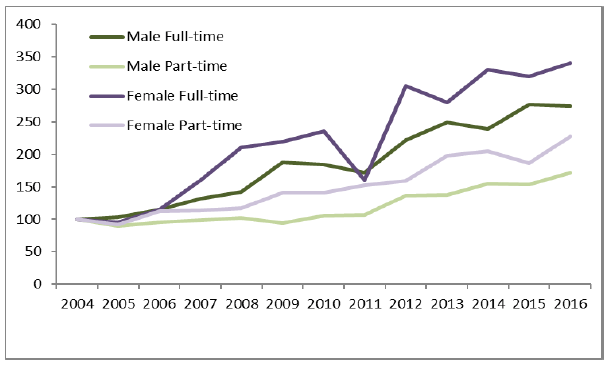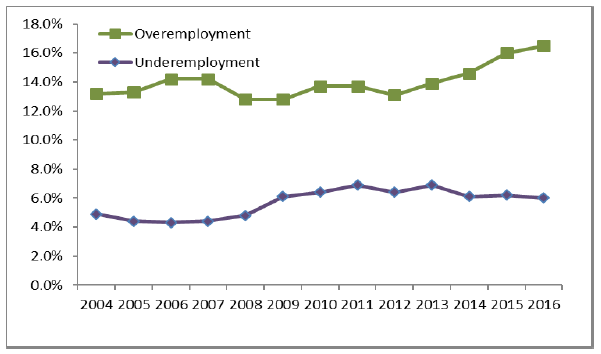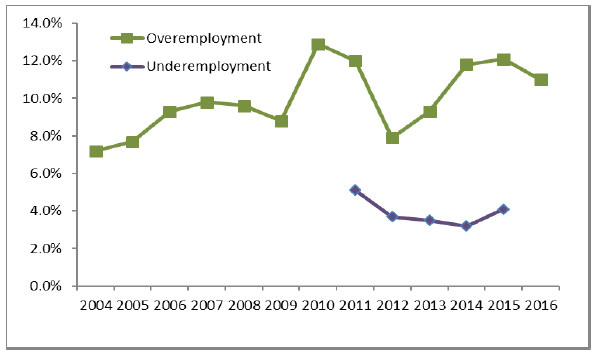Older people and employment in Scotland: research
An examination of attitudes and issues surrounding an older workforce.
Chapter 1: Introduction to the research
1.1 Background to the research
Population ageing across all Western economies, including Scotland, has prompted much policy attention on extending working lives beyond traditional retirement ages as a way of helping governments to balance expenditure on older citizens with tax revenues. The demographic change, however, can offer a range of opportunities to support an ageing population maintain fulfilling working lives. An initial investigation of later-life working in Scotland [4] highlighted the increase in so-called 'pensioner' employment, i.e. those still in paid work beyond the age of eligibility for state pension (65 for men and rising from 60 to 65 for women between 2010-2018). The report identified several benefits of later-life working, ranging from fiscal contribution to personal financial motivations and well-being. However, it also highlighted some concerns around issues of health, equality (gender pay gap in older age cohorts, age discrimination and limited access to work for lower income households) and fair work and employability (skill depreciation and limited investment in training older workers).
This research study was designed to build on that initial investigation of later-life working in Scotland. It fulfils the Scottish Government's pledge to undertake further research with older people on the topic of a thriving third age [5] . Whilst the initial investigation focused on the over-65s, the research reported here broadens the focus to include those aged between 50 and 64. It also aims to deepen the analysis - to interrogate the attitudes, behaviours and preferences underlying the statistical analysis. In this report we present data collected from both older employees and from employers. In addition, the research also explored the experiences of self-employed older people, and older people actively seeking employment. The analysis presented here offers insights into the opportunities, choices and constraints around extending working lives in Scotland, with a particular focus on improving employment policy and practice.
1.2 Current trends
The numbers of people aged 50+ in the Scottish workforce have increased steadily over the past 10-15 years. Figures 1 and 2 below illustrate this growth, from 2004-2016.
Figure 1: Employment of men and women aged 50-64 from 2004 to 2016

Source: Annual Population Survey 2016, Regional Employment Patterns in Scotland
Figure 2: Employment of men and women aged 65+ from 2004 to 2016

Source: Annual Population Survey 2016, Regional Employment Patterns in Scotland
While some of this growth can be attributed to the overall increase in the population in these age groups, employment rates still show an increase. In 2004, 61.8% of people aged 50-64 and 5.2% of those aged 65+ were in paid employment; by 2016 these rates had increased to 68.8% and 9.1% respectively. Nonetheless, these statistics also indicate that there is scope to increase employment even further, particularly as the projected old-age dependency ratio will continue to increase [6] .
As illustrated by Figures 3 and 4 below, there is evidence that a significant minority of older workers would like to work fewer hours than they do currently, even taking into account a loss of income (overemployment).
Overemployment of older people aged 50-64 has been steadily increasing suggesting that older they may wish to reduce their working hours while remaining in employment. There is also a smaller group who would like to work more hours than they currently do (underemployment).
Figure 3: Over- and underemployment among people aged 50-64

Source: Annual Population Survey 2016, Regional Employment Patterns in Scotland
Trends in over and under-employment of older people aged over 65 suggest that there are higher numbers who would like to work fewer hours than there are numbers seeking to increase their working hours. However, in the past two years over-employment rate has been falling and a smaller group of over 65s would like to work more hours than they currently do.
Figure 4: Over- and underemployment among people aged 65+

Source: Annual Population Survey 2016, Regional Employment Patterns in Scotland
1.3 Research aims and objectives
The overall aim of the research was to develop understanding of the motivations, opportunities and barriers experienced by older people (defined here as aged 50+) and employers around later-life working, in order to inform policies on increasing the participation of older people in the Scottish workforce.
The objectives of the research were to:
- Gather data from a variety of older people (employed, unemployed, self-employed) on their motivations to extend their working lives and the barriers they may face in doing so.
- Gain insight into the perspectives of a range of employers on the experiences, opportunities and challenges surrounding the extension of working lives and a potentially older workforce.
- Formulate a range of policy recommendations, based upon an analysis of empirical evidence generated by both this research, and other recent relevant studies.
Contact
There is a problem
Thanks for your feedback